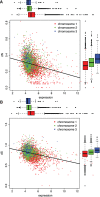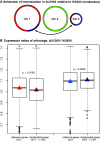Evolutionary effects of translocations in bacterial genomes
- PMID: 23160175
- PMCID: PMC3542574
- DOI: 10.1093/gbe/evs099
Evolutionary effects of translocations in bacterial genomes
Abstract
It has become clear that different genome regions need not evolve uniformly. This variation is particularly evident in bacterial genomes with multiple chromosomes, in which smaller, secondary chromosomes evolve more rapidly. We previously demonstrated that substitution rates and gene dispensability were greater on secondary chromosomes in many bacterial genomes. In Vibrio, the secondary chromosome is replicated later during the cell cycle, which reduces the effective dosage of these genes and hence their expression. More rapid evolution of secondary chromosomes may therefore reflect weaker purifying selection on less expressed genes. Here, we test this hypothesis by relating substitution rates of orthologs shared by multiple Burkholderia genomes, each with three chromosomes, to a study of gene expression in genomes differing by a major reciprocal translocation. This model predicts that expression should be greatest on chromosome 1 (the largest) and least on chromosome 3 (the smallest) and that expression should tend to decline within chromosomes from replication origin to terminus. Moreover, gene movement to the primary chromosome should associate with increased expression, and movement to secondary chromosomes should result in reduced expression. Our analysis supports each of these predictions, as translocated genes tended to shift expression toward their new chromosome neighbors despite inevitable cis-acting regulation of expression. This study sheds light on the early dynamics of genomes following rearrangement and illustrates how secondary chromosomes in bacteria may become evolutionary test beds.
Figures


Similar articles
-
Why genes evolve faster on secondary chromosomes in bacteria.PLoS Comput Biol. 2010 Apr 1;6(4):e1000732. doi: 10.1371/journal.pcbi.1000732. PLoS Comput Biol. 2010. PMID: 20369015 Free PMC article.
-
Periodic Variation of Mutation Rates in Bacterial Genomes Associated with Replication Timing.mBio. 2018 Aug 21;9(4):e01371-18. doi: 10.1128/mBio.01371-18. mBio. 2018. PMID: 30131359 Free PMC article.
-
Chromosome translocation and its consequence in the genome of Burkholderia cenocepacia AU-1054.Biochem Biophys Res Commun. 2010 Dec 17;403(3-4):375-9. doi: 10.1016/j.bbrc.2010.11.039. Epub 2010 Nov 13. Biochem Biophys Res Commun. 2010. PMID: 21078295
-
[Prokaryotic and Mitochondrial Linear Genomes: Their Genesis, Evolutionary Significance, and the Problem of Replicating Chromosome Ends].Mol Biol (Mosk). 2019 Mar-Apr;53(2):218-224. doi: 10.1134/S0026898419020125. Mol Biol (Mosk). 2019. PMID: 31099772 Review. Russian.
-
Order and disorder in bacterial genomes.Curr Opin Microbiol. 2004 Oct;7(5):519-27. doi: 10.1016/j.mib.2004.08.006. Curr Opin Microbiol. 2004. PMID: 15451508 Review.
Cited by
-
Influence of genomic variations on glanders serodiagnostic antigens using integrative genomic and transcriptomic approaches.Front Vet Sci. 2023 Dec 6;10:1217135. doi: 10.3389/fvets.2023.1217135. eCollection 2023. Front Vet Sci. 2023. PMID: 38125681 Free PMC article.
-
Mutation Landscape of Base Substitutions, Duplications, and Deletions in the Representative Current Cholera Pandemic Strain.Genome Biol Evol. 2018 Aug 1;10(8):2072-2085. doi: 10.1093/gbe/evy151. Genome Biol Evol. 2018. PMID: 30060177 Free PMC article.
-
Identification and analysis of genomic islands in Burkholderia cenocepacia AU 1054 with emphasis on pathogenicity islands.BMC Microbiol. 2017 Mar 27;17(1):73. doi: 10.1186/s12866-017-0986-6. BMC Microbiol. 2017. PMID: 28347342 Free PMC article.
-
Genome-Wide Biases in the Rate and Molecular Spectrum of Spontaneous Mutations in Vibrio cholerae and Vibrio fischeri.Mol Biol Evol. 2017 Jan;34(1):93-109. doi: 10.1093/molbev/msw224. Epub 2016 Oct 15. Mol Biol Evol. 2017. PMID: 27744412 Free PMC article.
-
Natural Chromosome-Chromid Fusion across rRNA Operons in a Burkholderiaceae Bacterium.Microbiol Spectr. 2022 Feb 23;10(1):e0222521. doi: 10.1128/spectrum.02225-21. Epub 2022 Jan 5. Microbiol Spectr. 2022. PMID: 34985328 Free PMC article.
References
-
- Altschul SF, Gish W, Miller W, Myers EW, Lipman DJ. Basic local alignment search tool. J Mol Biol. 1990;215:403–410. - PubMed
-
- Couturier E, Rocha EP. Replication-associated gene dosage effects shape the genomes of fast-growing bacteria but only for transcription and translation genes. Mol Microbiol. 2006;59:1506–1518. - PubMed
Publication types
MeSH terms
LinkOut - more resources
Full Text Sources

